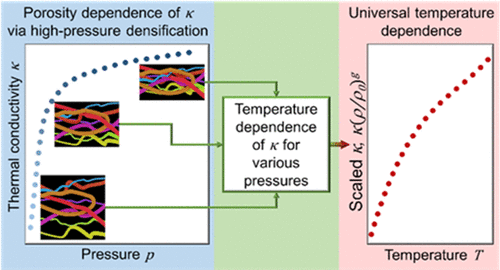当前位置:
X-MOL 学术
›
Biomacromolecules
›
论文详情
Our official English website, www.x-mol.net, welcomes your
feedback! (Note: you will need to create a separate account there.)
Thermal Conductivity of Cellulose Fibers in Different Size Scales and Densities
Biomacromolecules ( IF 5.5 ) Pub Date : 2021-08-17 , DOI: 10.1021/acs.biomac.1c00643 Mathis Antlauf 1 , Nicolas Boulanger 1 , Linn Berglund 2 , Kristiina Oksman 2 , Ove Andersson 1
Biomacromolecules ( IF 5.5 ) Pub Date : 2021-08-17 , DOI: 10.1021/acs.biomac.1c00643 Mathis Antlauf 1 , Nicolas Boulanger 1 , Linn Berglund 2 , Kristiina Oksman 2 , Ove Andersson 1
Affiliation

|
Considering the growing use of cellulose in various applications, knowledge and understanding of its physical properties become increasingly important. Thermal conductivity is a key property, but its variation with porosity and density is unknown, and it is not known if such a variation is affected by fiber size and temperature. Here, we determine the relationships by measurements of the thermal conductivity of cellulose fibers (CFs) and cellulose nanofibers (CNFs) derived from commercial birch pulp as a function of pressure and temperature. The results show that the thermal conductivity varies relatively weakly with density (ρsample = 1340–1560 kg m–3) and that its temperature dependence is independent of density, porosity, and fiber size for temperatures in the range 80–380 K. The universal temperature and density dependencies of the thermal conductivity of a random network of CNFs are described by a third-order polynomial function (SI-units): κCNF = (0.0787 + 2.73 × 10–3·T – 7.6749 × 10–6·T2 + 8.4637 × 10–9·T3)·(ρsample/ρ0)2, where ρ0 = 1340 kg m–3 and κCF = 1.065·κCNF. Despite a relatively high degree of crystallinity, both CF and CNF samples show amorphous-like thermal conductivity, that is, it increases with increasing temperature. This appears to be due to the nano-sized elementary fibrils of cellulose, which explains that the thermal conductivity of CNFs and CFs shows identical behavior and differs by only ca. 6%. The nano-sized fibrils effectively limit the phonon mean free path to a few nanometers for heat conduction across fibers, and it is only significantly longer for highly directed heat conduction along fibers. This feature of cellulose makes it easier to apply in applications that require low thermal conductivity combined with high strength; the weak density dependence of the thermal conductivity is a particularly useful property when the material is subjected to high loads. The results for thermal conductivity also suggest that the crystalline structures of cellulose remain stable up to at least 0.7 GPa.
中文翻译:

不同尺寸尺度和密度的纤维素纤维的热导率
考虑到纤维素在各种应用中的使用越来越多,对其物理特性的了解和理解变得越来越重要。热导率是一个关键特性,但其随孔隙率和密度的变化是未知的,并且不知道这种变化是否受纤维尺寸和温度的影响。在这里,我们通过测量源自商业桦木浆的纤维素纤维 (CF) 和纤维素纳米纤维 (CNF) 的热导率作为压力和温度的函数来确定这些关系。结果表明,热导率随密度变化相对较弱(ρ样品= 1340-1560 kg m –3) 并且它的温度依赖性在 80-380 K 的温度范围内与密度、孔隙率和纤维尺寸无关。 CNF 随机网络的热导率的通用温度和密度依赖性由三阶多项式描述函数(SI-单位):κ CNF = (0.0787 + 2.73 × 10 –3 · T – 7.6749 × 10 –6 · T 2 + 8.4637 × 10 –9 · T 3 )·(ρ sample /ρ 0 ) 2,其中ρ 0 = 1340 kg m –3和 κ CF = 1.065·κ CNF. 尽管结晶度相对较高,但 CF 和 CNF 样品都显示出类似无定形的热导率,即随温度升高而增加。这似乎是由于纤维素的纳米级基本原纤维,这解释了 CNF 和 CF 的热导率表现出相同的行为,仅相差约 6%。纳米尺寸的原纤维有效地将声子平均自由程限制在几纳米,以便在纤维间进行热传导,而对于沿纤维进行高度定向的热传导,该时间仅显着更长。纤维素的这一特性使其更容易应用于需要低导热性和高强度的应用中;当材料承受高负载时,热导率的弱密度依赖性是一个特别有用的特性。
更新日期:2021-09-13
中文翻译:

不同尺寸尺度和密度的纤维素纤维的热导率
考虑到纤维素在各种应用中的使用越来越多,对其物理特性的了解和理解变得越来越重要。热导率是一个关键特性,但其随孔隙率和密度的变化是未知的,并且不知道这种变化是否受纤维尺寸和温度的影响。在这里,我们通过测量源自商业桦木浆的纤维素纤维 (CF) 和纤维素纳米纤维 (CNF) 的热导率作为压力和温度的函数来确定这些关系。结果表明,热导率随密度变化相对较弱(ρ样品= 1340-1560 kg m –3) 并且它的温度依赖性在 80-380 K 的温度范围内与密度、孔隙率和纤维尺寸无关。 CNF 随机网络的热导率的通用温度和密度依赖性由三阶多项式描述函数(SI-单位):κ CNF = (0.0787 + 2.73 × 10 –3 · T – 7.6749 × 10 –6 · T 2 + 8.4637 × 10 –9 · T 3 )·(ρ sample /ρ 0 ) 2,其中ρ 0 = 1340 kg m –3和 κ CF = 1.065·κ CNF. 尽管结晶度相对较高,但 CF 和 CNF 样品都显示出类似无定形的热导率,即随温度升高而增加。这似乎是由于纤维素的纳米级基本原纤维,这解释了 CNF 和 CF 的热导率表现出相同的行为,仅相差约 6%。纳米尺寸的原纤维有效地将声子平均自由程限制在几纳米,以便在纤维间进行热传导,而对于沿纤维进行高度定向的热传导,该时间仅显着更长。纤维素的这一特性使其更容易应用于需要低导热性和高强度的应用中;当材料承受高负载时,热导率的弱密度依赖性是一个特别有用的特性。











































 京公网安备 11010802027423号
京公网安备 11010802027423号